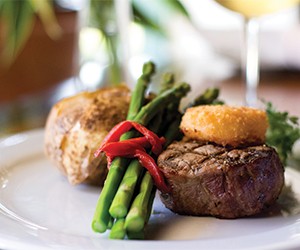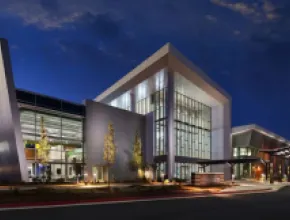The impulse that drove pioneers to the Oklahoma frontier was essentially a creative one. Faced with the blank slate of prairie land, settlers built thriving communities and later discovered fortunes hidden beneath the grasslands. The artistic and architectural traditions they brought with them blossomed in the new state.
Many Native American tribes have called Oklahoma home for hundreds of years, and more than three dozen nations are recognized in the state today. Their carefully preserved traditions of art, dance, crafts and storytelling are still alive.
The resilience, ingenuity and creativity of both pioneers and Native Americans have shaped the culture of Oklahoma through good times and bad. Its cultural venues will delight groups with their unique spirit.
Tulsa
Once rich in oil, Tulsa is now wealthy in art, architecture and lively musical traditions.
"Our fabulous mixture of cultural flavor in Tulsa starts from the early Native American inhabitants to the cattlemen, the coming of the railroads and the oil boom," says Amy Huntley, vice president of VisitTulsa. "You will be amazed at the influences each one brought to our region."
Home to the Creek and Lochapoka tribes of Native Americans since the 1830s, Tulsa became the country’s oil capital upon the discovery of petroleum in the early 1900s. Many of the area’s wealthy oilmen built stately mansions with attached gardens, and some began to collect art. In the prevailing decades several of these lordly estates have been converted into popular attractions.
Among them, Gilcrease Museum of the Americas holds a collection of more than 250,000 anthropological specimens from Native American cultures. The museum also houses a noteworthy fine art collection and 23 acres of theme gardens. Guided group tours are available, and reservations should be made three weeks in advance. Gilcrease can also provide speakers on state history and native culture for events.
Phillbrook Museum of Art is housed in an Italian Renaissance villa gifted to the city by Wait Phillips of Phillips Oil. The renowned museum showcases priceless collections of art from around the world as well as enchanting gardens and nationally touring exhibitions. The museum offers an 80-person conference room, a 235-seat auditorium and a reception gallery accommodating 300 for banquets.
The prosperous era of oil wealth brought waves of development to Tulsa and the city boasts one of the largest numbers of Art Deco buildings of any in the U.S. There has even been talk of building an Art Deco museum in the city. In total, Tulsa has 14 districts listed on the National Register of Historic Places.
One handsome example is the Pavilion at Expo Square, a historic arena built in 1932. The blond brick edifice, developed for livestock shows, features colorful terra cotta details and seats 10,000 with 22 VIP sky boxes.
Guided tours are a great way to take in Tulsa’s architecture and history. Bandana Tours can take groups on walking tours of Art Deco and terra cotta structures, fabulous churches and the grand dwellings of "Black Gold Row."
Some of the city’s most beautiful architecture can be found in its hippest neighborhoods. Attendees can leave the guides behind and explore the nightlife of the Blue Dome District or the funky, one-of-a-kind shops of Cherry Street on their own.
One of the most tragic chapters in Tulsa’s history is now commemorated at the John Hope Franklin Center for Reconciliation. The bloody 1921 Tulsa Race Riot killed 39 people, injured 800 and destroyed more than 1,200 residences. Completed in late 2009, the center and the attached Reconciliation Park seek to promote social progress, racial justice and harmony between people. The facility is free and open to the public.
Speaking of harmony, Tulsa’s rich musical heritage includes contributions to jazz and the creation of Western Swing music. The Oklahoma Jazz Hall of Fame, located in the historic Union Depot building, is capable of hosting groups of 550. Cain’s Ballroom was known as the "Carnegie Hall of Western Swing." The 1927 dancehall can welcome as many as 1,700 for live performances.
No visit to Oklahoma is complete without a visit to Discoveryland, located just west of Tulsa on I-64. The beloved musical Oklahoma! is presented outdoors complete with live horses and of course an authentic surrey with the fringe on top. Groups of 20 or more can receive discounted show tickets or choose a VIP package that includes a ranch dinner.
Oklahoma City
The largest city of the Great Plains, Oklahoma City has a colorful Western legacy. Its museums capture the romance of the westward expansion era.
"Oklahoma City is the real West," says Michael J. Carrier, president of the Oklahoma City CVB. "With 39 Indian tribes and nations in the state, we have Native America all around and in our city. The true Western values of honesty and friendship are evident in everyone you meet and the history of the state and city are on display everywhere."
Resilience is a key virtue of the Western spirit, and Oklahoma City has overcome more adversity than most communities, including the second-most destructive terrorist attack ever on American soil.
"The most significant ‘must’ is a visit to the Oklahoma City National Memorial & Museum," Carrier says. "The site of the April 19, 1995, Murrah Federal Building bombing, this memorial shows the resilience of the people of Oklahoma."
The anti-government bombing took the lives of 168 people and injured hundreds more. Exhibits allow visitors to experience the chaos of the blast, educate them about terrorism and commemorate the fallen. The facility is available for events and can host as many as 250.
Proud of its native roots, Oklahoma City offers visiting groups a number of ways to explore American Indian history and culture. Scheduled to open in 2014, the American Indian Cultural Center and Museum will provide more fantastic opportunities to learn about local native peoples. Jim Thorpe Museum and Oklahoma Sports Hall of Fame celebrates the life and achievements of the famous Native American Olympian and great Oklahoma athletes. The museum offers an events center that can host 600. Indian City, a 65-mile drive southwest of Oklahoma City, is a restoration of seven Plains Indian villages. Groups can explore the village on guided tours, watch Native American dances and seasonal ceremonies, and shop for handmade crafts.
The National Cowboy & Western Heritage Museum immortalizes all things Wild West. Visitors can view early rodeo trophies, firearms and saddlery, Native American and Western artwork, and three halls dedicated to great Westerners, Western performers and rodeo stars, respectively. The museum can host groups as large as 1,800 for events.
The 215,000-square-foot Oklahoma History Center offers more than 200 exhibits and activities relating to culture, heritage, commerce and geology in the state. The facility can host receptions of as many as 1,000.
Apart from its indomitable nature and rawhide past, Oklahoma City is an urban center with all of the sophistication and amenities that entails. Oklahoma City Museum of Art boasts collections of American and European art as well as a large installation of Dale Chihuly glass sculptures. Event spaces include 13 galleries, a 250-seat theater and the lobby, which can host 350 for receptions.
Culture can also be enjoyed in edible, potable and aural forms, and Oklahoma City’s neighborhoods don’t disappoint. Bricktown offers restaurants, watering holes and live music venues galore. These include the American Banjo Museum, which can accommodate as many as 60 for private events in a replica Shakey’s Pizza Parlor. The Western flavor of historic Stockyards City and the ethnic restaurants of the Paseo Arts District are just two more slices of this intriguing city ripe for exploring.
Norman
The state’s foremost college town, Norman is gifted with an abundance of arts and international cultural resources.
"The University of Oklahoma with its broad and diverse representation of students and faculty from around the world gives Norman a diverse culture over any other Oklahoma community," says Stephen Koranda, executive director of the Norman CVB. "With ample notice, a meeting planner could schedule a student or faculty member to speak at their meeting."
Among the university’s many exciting off-site venues is Fred Jones Jr. Museum of Art, which can welcome as many as 200, and Sam Noble Museum of Natural History, which can host groups as large as 425. Entertainment options are rife; the UO Arts District presents more than 350 events per year, including musicals, plays, concerts and arts exhibitions by talented young performers.
Shawnee
For a city of fewer than 30,000 people, Shawnee packs quite the cultural punch.
"Shawnee is full of life and cultural flavor," says Kinlee Farris, sales manager at the Shawnee CVB. "Our Citizen Potawatomi Nation Cultural Heritage Center houses the tribe’s artifact treasures. Shawnee also lays claim to Oklahoma’s only Egyptian mummy at the Mabee-Gerrer Museum of Art. Her name is Tutu and she’s on display year-round."
Citizen Potawatomi Nation Cultural Heritage Center preserves the tribe’s heritage, supports genealogy studies and offers handmade arts and crafts in its gift shop. Its Long Room can hold 800. The Citizen Potawatomi Tribe Reunion Halls can welcome as many as 400.
Located on the campus of St. Gregory’s University, Mabee-Gerrer Museum of Art is available for events as large as 160. In addition to its Egyptian antiquities, the museum holds a large collection of artwork dating from the Greek and Roman era through the Middle Ages to the early 20th century.
The area is also known for its barbeque, especially from Van’s Pig Stands. From May through August, groups will enjoy a visit to Country Cottage Primitives Lavender Farm for fragrant, fresh-grown lavender.
Kelly Crumrin is a frequent contributor to Meetings Focus.






